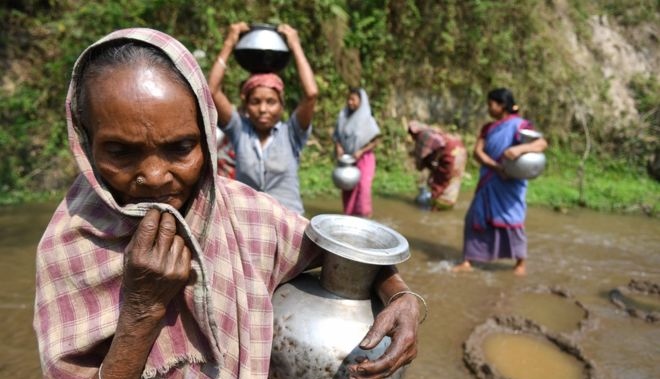Worst Water Crisis in India
June 16, 2018 | Expert Insights

India is facing the worst water crisis in history as demand for water has far surpassed the supply, risking the lives of millions, according to the government think tank NITI Aayog.
By 2030, India’s water demand is projected to be twice the available supply, implying severe water scarcity for hundreds of millions of people and an eventual 6% loss in the country’s GDP.
Background
The National Institution for Transforming India, also called NITI Aayog, was formed via a resolution of the Union Cabinet on January 1, 2015. NITI Aayog is the premier policy ‘Think Tank’ of the Government of India, providing both directional and policy inputs. While designing strategic and long-term policies and programmes for the Government of India, NITI Aayog also provides relevant technical advice to the Centre and States. It has been seen as a successor to the Planning Commission which would formulate Ten Year, Five Year, and Annual Plans for the progress and development of India.
Accounting for over 50% of Indian employment, the agriculture and allied sectors are heavily dependent on the monsoons and a continuous supply of water during hot summers. Although it contributes to nearly 8% of world agricultural output, India’s primary sector employs the weakest economic sections. Most farmers are either in severe debt, or marginally above poverty. Access to advanced technology for irrigation or potable water is devastatingly low.
In the past, droughts have periodically led to major Indian famines, including the Bengal famine of 1770, in which up to one third of the population in affected areas died; the 1876–1877 famine, in which over five million people died; and the 1899 famine, in which over 4.5 million died. Overlooking colonial rule and misappropriation of India’s treasury, episodes of severe drought correlate with El Niño-Southern Oscillation (ENSO) events. The extent to which an ENSO event raises sea surface temperatures in the central Pacific Ocean influences the degree of drought. Around 43% of El Niño events are followed by drought in India.
Analysis
Currently, 600 million Indians face high to extreme water stress and about two lakh people die every year due to inadequate access to safe water. According to NITI Aayog, a fundamental challenge to overcoming the crisis is the lack of water data. Most systems are limited in their coverage, robustness and efficiency.
Nearly 163 million of India’s population of 1.3 billion lack access to clean water close to home, the most of any country, according to a 2018 report by Britain-based charity WaterAid. It is expected that with the current rise in population, water scarcity will be more acute. Moreover, current water crises are predominantly centred around the more populous states of North India.
Twenty-one cities, including Delhi, Bengaluru, Chennai and Hyderabad will run out of groundwater by 2020, affecting 100 million people, the study noted. Gujarat, Andhra Pradesh and Madhya Pradesh have the top ranks for effective water management.
Interstate disagreements regarding river water appropriation have increased. Currently there are seven major disputes which point to the lack of an overarching framework to combat these conflicts. Moreover, large influx of tourists to water-scarce regions like Shimla has resulted in states like Himachal Pradesh requesting tourists to avoid the hilly township; however, thousands of families are dependent on tourism to earn enough to buy water from tankers as local wells and streams run dry.
“Critical groundwater resources that account for 40% of India’s water supply are being depleted at unsustainable rates,” the report said, calling for an immediate push towards sustainable management of water resources. Up to 70% of India’s water supply is “contaminated.”
The National Institute for Transforming India (NITI) Aayog has developed the Composite Water
Management Index (CWMI) in association with the country's Ministry of Water Resources, the Ministry of Drinking Water and Sanitation, and the Ministry of Rural Development. The Index and the associated report are expected to: establish a clear baseline and benchmark for state-level performance on key water indicators; uncover and explain how states have progressed on water issues over time, including identifying high-performers and under-performers, thereby inculcating a culture of constructive competition among states; and, identify areas for deeper engagement and investment on the part of the states.
“There is great awareness now about air pollution, however, India’s water crisis does not get that kind of attention,” said Rajiv Kumar, Vice-Chairman, NITI Aayog.
Assessment
Our assessment is that the new index will provide central and state governments with the data necessary to formulate policies for effective water management. We believe that the onus falls not only on the government, but also on citizens to curb water waste on a daily basis. As such, awareness drives will be launched by the government, but rural access to water may not be prioritised in due time.
Read more: Bangalore’s water








Comments